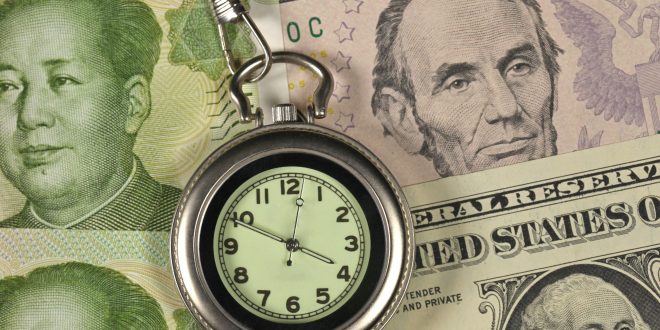Last week saw the impeachment trial of former United States President Donald Trump takes place at the Senate on the charge of inciting an insurrection after his followers stormed the Capitol on January 6.
Over the weekend, Trump was acquitted in his second impeachment trial, as once again not enough Senators voted to convict him.
The U.S. Senate voted 57 to 43 on whether Trump was guilty of inciting an insurrection, with seven Republican Senators voting alongside the Democrats to convict the former president, but at least 67 votes were needed for a conviction.
Meanwhile, the Coronavirus pandemic continues to weigh on major economies as the vaccine spread slowly increases.
In a speech to the European Parliament, President of the European Central Bank (ECB) Christine Lagarde acknowledged that the start of vaccination campaigns provides hope, but noted that people across Europe are still facing the dire social and economic consequences of the Coronavirus pandemic and that the future remains uncertain.
Speaking about inflation, Lagarde said that despite the steep increase in January due to a confluence of factors, inflation remains low.
Meanwhile, the Chairman of the United States Federal Reserve, Jerome Powell, said that he does not see a large nor sustained rise in inflation. Powell further reiterated the stand that the Fed would not consider interest rate hikes even if the inflation rate briefly went above its 2% strategic target.
Markets are still anticipating the passing of a new stimulus plans in the United States through Congress.
The United States Secretary of the Treasury, Janet Yellen, has called upon G7 countries to go big on stimulus spending to help economies recover from the impacts of the pandemic.
Bitcoin
Bitcoin rose to a new record high and approached $50,000 on Sunday (February 14th), taking advantage of a record high after Wall Street and Main Street increasingly adopted the world’s largest cryptocurrency.
Bitcoin price reached 48,700 dollars Sunday morning, up more than 3%.
It was traded as high as $ 49,714 earlier. The value of the cryptocurrency has increased by nearly 70% so far.
After a long period of traditional financial firms avoiding this currency, it appears that Bitcoin and other virtual currencies are increasingly entering the mainstream as a routine asset and payment method.
European Stocks
European stocks were able to reverse their earlier losses and closed the week with their second consecutive weekly gains. The STOXX Europe 600 index registered weekly gains of 1% and rose to its best level in three weeks.
Stock markets in Europe were positively impacted by an improvement in risk sentiment and positive earnings reports by some major listed companies, as well as gains by the technology sector.
US Stocks
The two indices S&P 500 and Nasdaq Composite reached record highs closing levels Friday, as investors bought into energy stocks, financial and materials companies and sold shares of large technology in anticipation of new financial support from Washington to help the US economy recover.
The main indices remained in a narrow range during the week as investors left the growth stocks that dominated the rally that lasted for about a year to buy in the stocks linked to the economic cycle and those that are priced below their real value.
US Dollar
The US dollar was negatively affected by several factors that led it to a weekly decline last Friday, most notably the optimism sparked by the next round of stimulus, improvement in US earnings reports, and data that indicated an improvement in US jobs, although it came below markets’ expectation.
Powell’s remarks were directed against US Dollar, which retreated after Powell confirmed his support for more monetary stimulus through central bank measures and fiscal stimulus that is carried out by the federal government represented by the Treasury.
Gold
Gold prices scored their first weekly gains in three weeks, despite the rise in the U.S. Treasury yields, supported by an increased demand and hopes for extra stimulus in the U.S.
The most active gold futures rose by about 0.6% on a weekly basis, following two consecutive weeks of decline.
Meanwhile, silver futures registered a weekly gain of about 1%.
Oil
Oil prices continued to receive support from the commitment of the OPEC+ alliance to output cuts, as well as geopolitical tensions raising concerns about crude supplies from the Middle East.
Brent crude futures for April delivery gained 5.2% for the week, to close at $62.43 per barrel. Meanwhile, the West Texas Intermediate (WTI) crude futures finished at $59.47 per barrel, rising by 4.6% for the week.
Commercial crude oil inventories in the United States decreased by 6.6 million barrels last week, according to the weekly report of the U.S. Energy Information Administration (EIA).
Meanwhile, the weekly report of Baker Hughes showed that the number of active rigs drilling for oil in the United States increased by 7 to 306 last week, rising for the 12th consecutive week.
Treasury Yields
U.S. Treasury yields increased significantly, amid expectations of a rise in inflation. Return on the 10-year Treasury bonds rose by 3.1 basis points over the week to 1.199%, nearing its highest levels since March 2020. The yield on the 30-year bonds reached its highest level since February, after increasing by 3 basis points for the week. Meanwhile, the two-year note return remained nearly unchanged.
Data
The first data last week was the Eurozone GDP. The Eurozone economy contracted 0.7% on quarter in the three months to December of 2020, beating -1.2% expected.
On an annualized basis, the bloc’s GDP dropped by 5.1% in Q4 vs. -4.3% seen in Q3 2020 while beating -4.3% expected.
In the United Kingdom, the British economy expanded 1% QoQ in the final quarter of 2020 when compared to a massive 16% growth in Q3 and +0.5% expected. On an annualized basis, the Kingdom’s GDP arrived at -7.8% in Q4 vs. -8.1% expected and -8.6% previous.
The UK GDP monthly release showed that the economy expanded-more-than-expected in December, arriving at 1.2% vs. 1% expected and -2.6% previous.
Meanwhile, the Index of services (Dec) arrived at 0.6% 3M / 3M vs. 3.7% prior.
As for industrial activity in the United Kingdom, Manufacturing output arrived at 0.3% MoM in December versus 0.6% expected and 1.1% booked in November, while total industrial output came in at 0.2% vs. 0.5% expected and 0.3% last.
On an annualized basis, the UK manufacturing production figures came in at -2.5% in December, beating expectations of -3.3%. Total industrial output dropped by 3.3% in December, against a -3.8% expected and the previous -3.9%.
Separately, the UK goods trade balance numbers were published, which arrived at GBP-14.315 billion in December versus GBP-15.00 billion expectations and GBP-14.794 billion last. Total trade balance (non-EU) came in at GBP-5.20 billion in December versus GBP-3.538 billion expected.
In Germany, Industrial Production showed no growth in December, the official data showed on Monday, suggesting that the recovery in the manufacturing sector is faltering
The industrial output arrived at 0% MoM, the federal statistics authority Destatis said in figures adjusted for seasonal and calendar effects, vs. a 0.3% rise expected and 0.9% last.
On an annualized basis, the German industrial production dropped by 1% in December versus -2.5% booked in November.
There were 793,000 initial claims for unemployment benefits in the US during the week ending February 6. This reading followed the previous print of 812,000 and came in worse than the market expectation of 757,000.
 Noor Trends News, Technical Analysis, Educational Tools and Recommendations
Noor Trends News, Technical Analysis, Educational Tools and Recommendations





